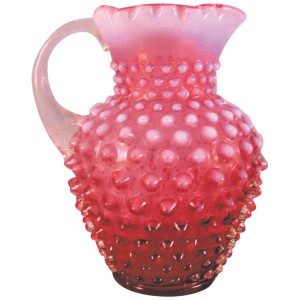In the early part of the 1900s the art glass industry in the U.S. was dominated by the works of Tiffany and Steuben. Beautiful as their creations were, their prices made them available only to the most affluent. But, that was about to change! In 1905 Frank and John Fenton opened a glassware factory and within a few short years they filled the marketplace with handmade art glass that was both beautiful and affordable. Over the next century their work would establish them as one of the most prolific and widely known manufacturers of art glass in the world, from the company they named . . .Fenton.
One of their greatest contributions to the world of collectible glassware came in the winter of 1907 with the introduction of Carnival glass. Carnival glass was sold in department stores beginning in 1905 and held strong as a favorite with the women of America for the next two decades. Many attribute its popularity to the fact that it mimicked the high-end art glass pieces from the Tiffany family, but at a fraction of the price. Then, as now, Fenton’s works are considered by many to be the finest examples of early Carnival glass.
As we approached the 1930s interest in Carnival waned and production ceased. However, in the 1970s we saw a resurgence in the popularity of iridescent glass as Fenton released what they referred to as “Original Formula Carnival.” This is what is known as a “revival.” Revivals are sometimes mistaken for reproductions, but there are two major differences. A revival is a new piece made by the same manufacturer as the original and it is not intended to deceive the buyer. Fenton’s “Original Formula Carnival” line included pieces that were made from their 1907-1929 molds plus molds they had purchased from competitors who had gone out of business. Each piece of this line is clearly marked on the bottom with the Fenton name in an oval.
The Great Depression saw the close of many of the American glass factories. Aware of the challenges in front of them, the Fentons added more practical items including perfume bottles, reamers and mixing bowls.
There are some patterns that we know at first glance to be Fenton. One of these would most definitely be Hobnail. Opalescent Hobnail glass in shades of cranberry, blue and green was introduced to the line in 1939. It would become their top seller through the decade and contributed to their survival through the war years of the 1940s.
From this same era comes Fenton’s longest continuous run line, “Crest” (1941-1978). Silver Crest, a white body with a clear glass ruffle is the most easily attainable pattern and is found in the form of vases, epergnes, bowls, and vanity sets. Also popular with collectors are Aqua Crest, Blue Crest, Emerald Crest, Gold Crest and a rare three-year issue named Rose Crest, which was produced from 1944-1947.
The 1950s saw many new releases from Fenton with two that are of particular interest to collectors. One of their most significant contributions was the introduction in 1953 of the Fenton basket which was formed by adding handles to existing bowls. Many of these handles will carry a maker’s mark. Milk glass was one of the most popular forms of collectible glass in the 1950s and to meet the demand Fenton released a line of white hobnail that sold from 1951-1960.
Nothing says MCM like a stretch glass vase and Fenton was among the top producers in the 1960s and 70s. Colors to watch for include Grecian Gold, Velva Rose, Persian Pearl and Celeste Blue. More difficult to find are the limited number made in Royal Blue.
After a run of financial difficulties and several major changes in management, Fenton closed its doors in 2011, leaving behind a massive body of work and many avid fans. If you are among those who collect Fenton there is no better time to add to your collection than now. Art glass, in general, is experiencing record low prices, making it a buyers market.
Linda Kennett is a professional liquidation consultant specializing in down-sizing for seniors and may be reached at 317-258-7835 or lkennett@indy.rr.com



